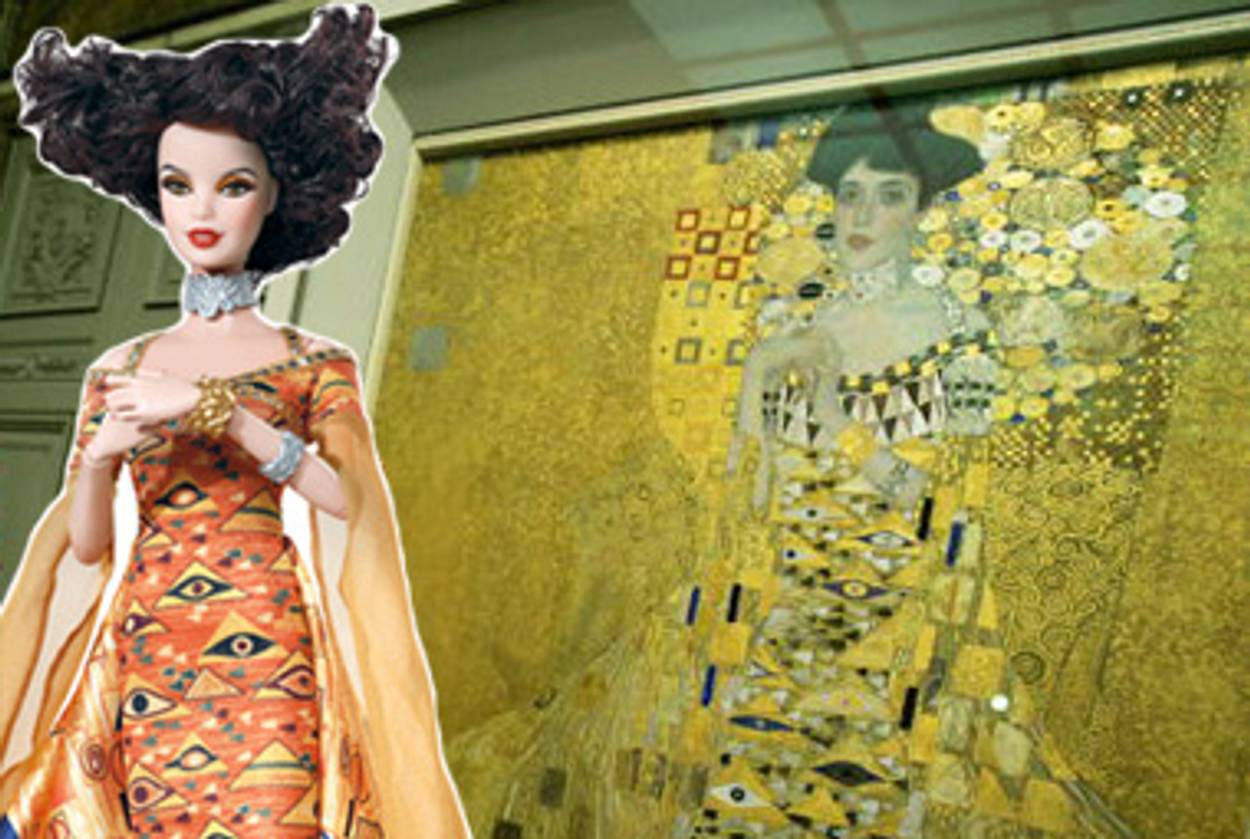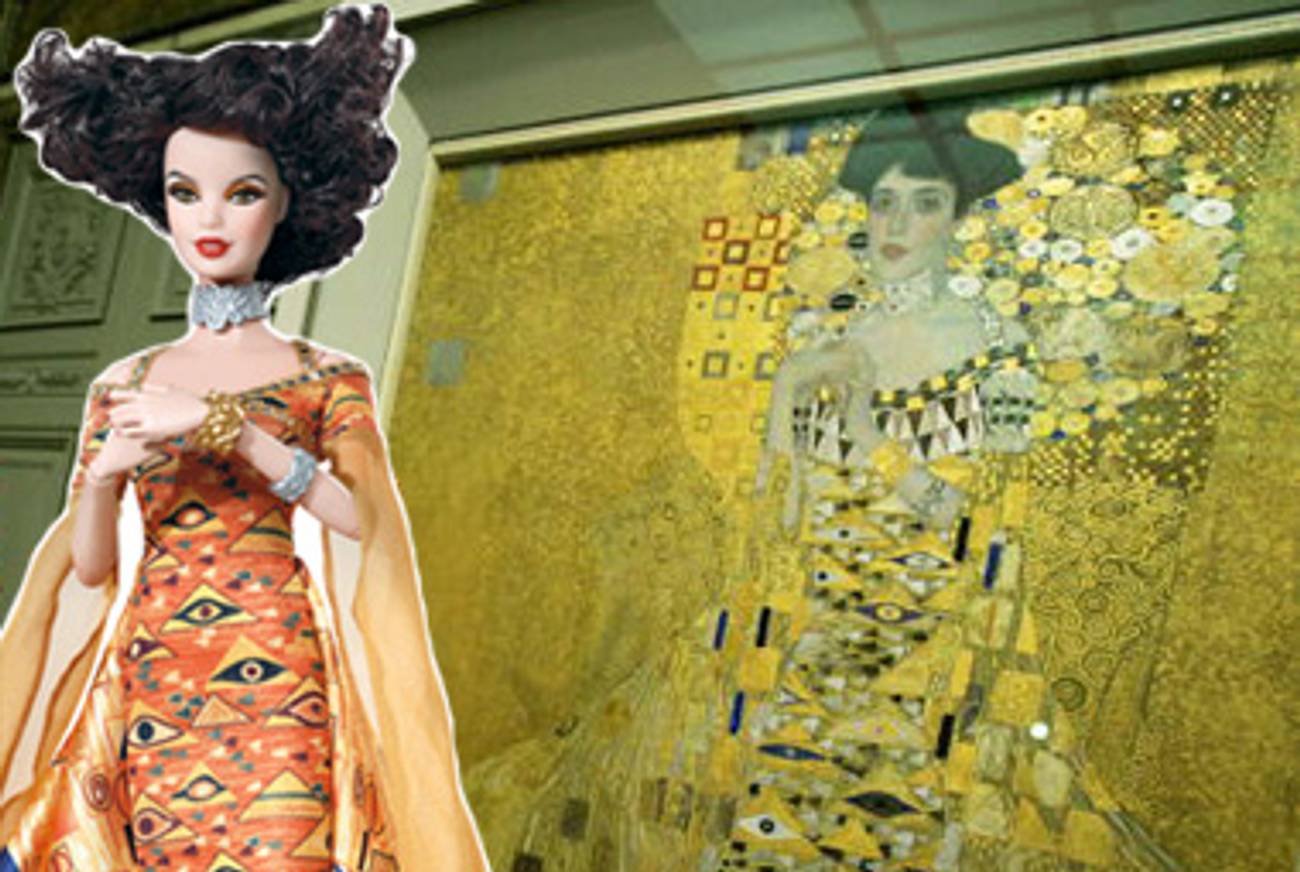Museum Barbie
A new doll is inspired by Adele Bloch-Bauer, Klimt’s famous Austrian Jewish model. It’s one of a new series of collector’s edition dolls dedicated to great works of art.




She was the model for (and possibly the lover of) Gustav Klimt, whose ravishing golden portrait of her, finished in 1907 and modeled on Byzantine mosaics of Empress Theodora in Ravenna, came to symbolize the edgy glamour of fin de siècle Vienna. But it was only after her death in 1925 that Adele Bloch-Bauer became a worldwide celebrity, when the shimmering portrait became the focus of an international legal battle over its status as Nazi war loot. Eventually restituted to the niece of the sitter, Portrait of Adele Bloch–Bauer Ibecame famous for yet another reason: In 2006, it was sold to Ronald Lauder for a reported $135 million, said to be the highest price paid for an artwork at the time. “Our Mona Lisa,” as Lauder called her, now resides in the Manhattan museum he founded, the Neue Galerie, across Fifth Avenue from the Metropolitan Museum, and she has begun earning her keep by inspiring a jewelry line designed and executed by experts from the Gem Palace Jaipur, offering such steals as an $8,750, 22-carat spiral cuff bracelet.
More recently, however, the brainy, beautiful muse of Austria’s avant-garde has inspired a product vastly lower in price but higher in cultural currency: a Barbie doll. The Klimt-inspired Barbie, in her glistening, geometric gown—along with, fittingly enough, a Mona Lisa-inspired Barbie, adorned in Renaissance finery, and a van Goghian Barbie, rocking a Starry Night cocktail dress—are the three inaugural offerings of the Barbie Collector Museum Collection. At $34.95 each, these dolls are aimed not at the youthful Barbie enthusiast—nor, for that matter, at the art enthusiast—but rather at the adult consumer, someone who might also acquire the glamorous, Project Runway-ready Barbie whose look was inspired by the Sydney Opera House.
That the Jewish grande dame of Vienna’s salons would become a classic American doll is less a stretch than it seems, given Barbie’s origins. She was created by Ruth Handler, daughter of Russian-Jewish immigrants, who took the concept from paper fashion dolls, the shape from a sexy German doll, and the name from her daughter. The product was available in blonde or brunette, with multiple outfits sold separately.
Though she was an immediate hit, Barbie was long maligned by intellectuals for her anatomical and political incorrectness. But now Handler’s creation is finally enjoying a post-modernist, post-feminist bump. The doll who has been toyed with by so many artists—sometimes lovingly, sometimes sadistically—is now a museum piece. The original 1959 Barbie Teen Age Fashion Model, known as Barbie No. 1, was recently acquired by the Los Angeles County Museum of Art, which will feature her (and Ken) in its upcoming show “California Design, 1930-1965: Living in a Modern Way.”
Barbie now has an iPad, according to her Twitter feed, and a subscription to Architectural Record. That’s for Architect Barbie, who debuts this fall. Part of a new line of professional Barbies, she almost didn’t happen until concerned women in the profession took up her cause, reasoning that there’s no point in throwing out the bombshell with the bathwater if there’s a chance to influence young women to take on the profession.
Architectural historian Despina Stratigakos recounts in Design Observer how, after lobbying for the production of Architect Barbie, she and a colleague worked with Mattel to develop the doll’s outfit. After much debate over the skirt vs. paints conundrum, they decided on a pink-and-blue A-line dress (topped with by a short-sleeve, wide-lapel jacket), black ankle boots (with a chunky heel), nerdy black glasses (on her head, not her face), a white hard hat, and a pink drawing tube. The feminine touches, Stratigakos explains, are “not an act of oppression, but of resistance,” channeling “girl power” by transcending restrictions and stereotypes of the past. (The doll is available in Caucasian and African American versions.) Real-life members of the American Institute of Architects, which supports the doll, can enter a competition to design Barbie’s Dream House. But in dreams begin responsibilities: Architect Barbie needs a home that is green and sustainable.
Adele Bloch-Bauer Barbie, on the other hand, is homeless. She is a collector’s item, not a role model. Removed from her real-life connections—to her past, the Holocaust, the courts, the art market—she’s all about that dress. Are there more chapters for this Viennese Jewish princess, other products to inspire? Appropriate quarters might be nice. Maybe one day a kid inspired by Architect Barbie will build Adele a dream house of her own, one to match the mansion in which her namesake’s painting now hangs.
Robin Cembalest is executive editor of ARTnews. She blogs at letmypeopleshow.com.
Robin Cembalest is executive editor of ARTnews. She blogs at letmypeopleshow.com. Her Twitter feed is @rcembalest.
Robin Cembalest is executive editor ofARTnews. She blogs at letmypeopleshow.com. Her Twitter feed is @rcembalest.